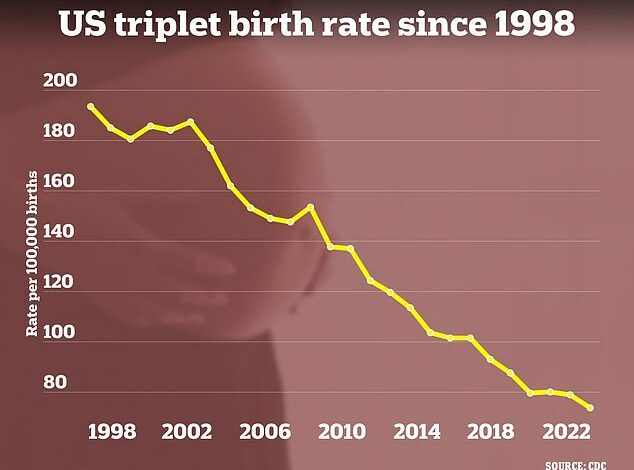Fascinating reason why Americans no longer have triplets



Data shows that the birth rate of triplets has more than halved in 30 years.
A CDC report Thursday found that triplets accounted for 193.5 per 100,000 births in 1998, compared to just 73.8 per 100,000 births in 2023.
Researchers attribute the decline mainly to a reduction in the number of embryos implanted during IVF due to safety concerns.
In the past, it was common for two or more fertilized embryos to be implanted to increase the chance that one would develop and cause a pregnancy.
This led to more cases of twins, triplets and quadruplets from 1980 onwards, as fertility treatments became more advanced, affordable and accessible.
In the mid-1990s, 30 percent of all IVF pregnancies resulted in twins, triplets or higher order births.
However, doctors were concerned about the number of twins and triplets born to people using IVF, because a pregnancy with more than one fetus is more likely to have complications than a pregnancy with one fetus.
This includes a greater chance of premature birth, miscarriage and conditions such as preeclampsia, in which blood pressure becomes dangerously high during pregnancy.

The National Center for Health Statistics had been keeping records of triplet pregnancies, or higher order pregnancies, for more than two decades

In natural births, approximately one in 10,000 births is triplets. If we add triplets from IVF, the rate of triplets during pregnancy is approximately 7.38 per 10,000 births.
Starting in the early 2000s, doctors began issuing rules on the number of embryos that could be implanted during IVF. Until 2004, they issued new guidelines almost every two years, which resulted in fewer multiple births.
Dr. Amanda Williams, the chief medical officer of March of Dimes, a nonprofit organization focused on maternal health, said multiple pregnancies can be significantly more dangerous and jeopardize the health of the mother and fetus.
Overall, Dr. Williams said: told CNN‘This is good news for families, because triplets and higher order pregnancies are so much riskier for mother and baby.’
The latest recommendations from the American Society for Reproductive Medicine recommend implanting only one embryo at a time in a woman undergoing IVF under the age of 35, and no more than four embryos at a time in a woman undergoing IVF under the age of 40.
About 240,000 women annually undergo IVF, in which a woman’s egg is fertilized with sperm outside the body and then implanted into her uterus in the hope of producing a viable pregnancy.
The new CDC report uses data from the National Center for Health Statisticsa division of the CDC, and looks at births in the US since 1998.
The decline between 1998 and 2023 was greater in some demographic groups than others – which epidemiologists say may be because certain groups, such as white people, had access to IVF treatments earlier than others.
Among white women, the triplet and higher birth rate has fallen 71 percent since 1998. Among Hispanic women, the triplet and higher birth rate has fallen 25 percent since 1998.
It appears that the rate at which triplets are conceived naturally has not changed significantly, but because it is a rare event, the data is not out of line with IVF trends.
About one in 10,000 pregnancies is natural triplets Hillcrest Medical Center.




